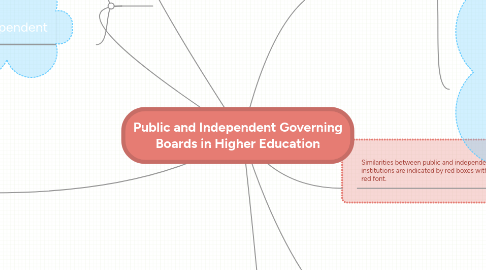
1. Structure
1.1. Public
1.1.1. As of 2010, 50.3% included at least one student voting member.
1.1.2. The average length of a term for trustees is six years.
1.1.3. Boards meet an average of seven times a year.
1.2. Independent
1.2.1. All institutions have boards but each board is unique to its institution.
1.2.2. As of 2010, 8.5% of boards included at least one student voting member. 12.5% of boards included at least one nonvoting student member.
1.2.3. Approximately half include at least one alumni representative.
1.2.4. The average length of a term for a trustee is 3-4 years.
1.2.5. Boards meet an average of three to four times a year.
2. Size
2.1. Public
2.1.1. The average amount of voting members per board is 11-12.
2.2. Independent
2.2.1. The average amount of voting members per board is 30.
3. References Pittman, J. (2016). Week 2 lecture notes. Pittman, J. (2016). Week 3 lecture notes. Pusser, B., Slaughter, S., & Thomas, S. (2006). Playing the board game: an empirical analysis of university trustee and corporate board interlocks. 77(5), 747-775.
4. Strengths and Weaknesses
4.1. Public
4.1.1. Strengths
4.1.1.1. Boards meet often.
4.1.1.2. Boards represent the needs of the local community.
4.1.2. Weaknesses
4.1.2.1. Institutions do not receive governmental funds.
4.2. Independent
4.2.1. Strengths
4.2.1.1. Boards have most, if not all, autonomy over their institution(s).
4.2.2. Weaknesses
4.2.2.1. Boards meet infrequently.
5. Similarities between public and independent institutions are indicated by red boxes with red font.
6. Demographics
6.1. Public
6.1.1. Men outnumber women 2:1, although the percentage of women is slowly increasing.
6.1.2. The average age of board members is 50-69.
6.1.3. Approximately half of trustees' professional backgrounds are in business.
6.2. Independent
6.2.1. Men outnumber women 2:1, although the percentage of women is slowly increasing.
6.2.2. The average age of board members is 50-69.
6.2.3. Approximately half of trustees' professional backgrounds are in business.
7. Terms
7.1. Public
7.1.1. Public boards serve colleges and universities that are owned by citizens as opposed to the government (Pittman, 2016).
7.1.2. There are three types of boards for public institutions.
7.1.2.1. Consolidated: one board governs two and four-year institutions OR one board governs are four-year institutions (two-year schools then have a different arrangement) (Pittman, 2016).
7.1.2.2. Segmental: separate boards govern different types of institutions such as research, community, etc.
7.1.2.3. Campus-level: full and autonomous authority of a singe campus
7.2. Independent
7.2.1. "legal owner and final authority" (Pittman, 2016)
7.2.2. have more freedom to be responsible for financial, physical, human assets and operations (Pittman, 2016)
7.2.3. federal government grants tax-exemption to help with philanthropy (Pittman, 2016)
7.2.4. many receive direct and indirect grants from state government (Pittman, 2016)

